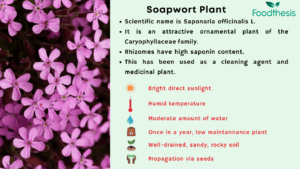Know in one minute about soapwort
|
Introduction
Soapwort (Saponaria officinalis L.) is an attractive ornamental plant belonging to the Caryophyllaceae family that can be found all over the world. This plant is growing in various habitats, usually along roadsides, in hedges, close to the water, and as a planted horticultural.
This plant is characterized by a high content of saponins found in the rhizomes (roots) of this plant. Due to this, it has been used through the centuries as a cleaning agent and medicinal plant. It also contains saporubin and saprubrinic acid, gums, flavonoids, Vitamin C, and vitexin (1).
Common name
Soapwort is known by many other common names including bouncing-bet, crow soap, wild sweet William, coven, fuller’s herb, and soapweed. It is also known as farewell summer, lady’s Washbowl, latheroot, and old maid’s Pink.
Geographical distribution
Widely distributed in the European part of the CIS, the Caucasus, Central Asia, Western Siberia, as well as throughout Central and Southern Europe.
Botanical description
Height and Stem
This plant is 30-100 cm tall and strongly branched at the top. The stem is ribbed, round, and hairless.
Rhizome or root
The root produces abundant reddish-brown or orange rhizomes which are inside yellowish and thick as a finger.
Leaves

They bear simple leaves that are roughly oval, smooth along the margins, and tapering in shape. The leaves may be waxy or covered in fine hairs.
Flower

The flowers are small, white or light pink, glossy, and contain five petals that begin to curve backward when flowers age. This flower form clusters at the ends of branches and has a pleasant floral scent that tends to attract butterflies. It blooms from May (June) to September.
Fruit
The fruit is a capsule that produces numerous dark brown seeds (2).
How to grow soapwort plant
Soapwort plants can be easily propagated in various ways like reseeding themselves through underground rhizomes.
It can also be grown using stem cuttings or division or by seeds. Sow seeds in spring, they sprout easily (three weeks) in warm, moist sandy soil. Make sure to space plants at least a foot (3 m.) apart as they will spread. The young plant thrives best in partial shade or bright filtered light in sunny locations.
How to care for soapwort plant

Soapwort is a hardy, vigorously growing plant that requires little maintenance and often forms colonies. Let’s discuss each of requiring conditions of this plant in detail
1. Planting
Soapwort is typically not ideal for planting in pots because it can get out of control and become invasive. So this plant grows best outdoors or in the garden.
2. Light
Soapwort plant needs bright direct sunlight to encourage more compact growth and maximize blooming. It also does well in a partially sheltered position.
3. Soil
This plant requires well-drained, sandy, and slightly rockier or gravelly soil for best growth.
4. Water
The herb prefers a moderate amount of water, but it can tolerate some drought. Irrigate often when the top of the soil becomes dry in summer.
5. Temperature and Humidity
This plant doesn’t like temperatures below 41°F (5°C). Soapwort plant does so well in normal humidity, but it also tolerates dry climates.
6. Fertilizer
Soapwort plants are friendly and easy to grow and can grow for years with little maintenance. It doesn’t require a lot of nutrients to fertilize about once per year in the spring.
7. Pruning
Pruning is necessary to maintain its size and limit invasive spreading. The best time for pruning is when the plant is finished blooming in the autumn.
8. Blooming
After the blooming of soapwort plant deadhead blooms once they have died out to encourage more blooms.
9. Harvesting and storing
Soapwort plants (flowers, young stems, roots, and leaves) can be harvested as needed throughout the season. It can be used in either fresh or dry form. However, to remain their importance of them they should be kept in airtight containers at room temperature.
Soapwort extract uses
1. Grown commercially for its saponin content. All parts of the plant like flowers, leaves, stems, and roots can be used in making mild soaps, detergents, and beer.
2. Detergent obtained from soapwort extract can be used for cleaning sheep wool before shearing, washing newly-woven cloth to thicken it.
3. The plant Soapwort has been used in traditional medicine for various diseases like roots as blood purifiers and diuretics (increase production of urine).
4. Soapwort saponins are active ingredients in many cosmetics and medical products.
5. The decoction of the roots is used in head washing to prevent hair loss (3), (4).
Benefits of Soapwort plant
1. Act as a natural detergent
The juice of the flowering stems and rhizomes are high in saponins which have cleansing and foaming properties (5). It can be used as a very gentle liquid soap, produced by boiling in water for household and cosmetics purposes (6).
2. Antimicrobial properties
Soapwort contains a phenolic compound that shows antimicrobial activity. It helps to fight against bacteria like Bacillus subtilis, Staphylococcus aureus, Salmonella typmiruim, Escherichia coli, Streptococcus thermophilus, Pseudomonas aeruginosa, and Klebsiella pneumonia (7). Furthermore, its root contains saponin that is effective to inhibit the growth of Candida albicans thus showing antifungal activity (8), (9).
3. Treat cancer
Soapwort is a source of saporin, which is one type of protein that can be applied in cancer therapy (10). This protein is effective to inhibit the growth of human cancer cells like blood cells, brain breast, and prostate cancer cells (11), (12).
4. Protect from cold stress
Saponin-rich soapwort helps to enhance the antioxidants and decrease lipid peroxidation in the blood. Thus soapwort is effective in preventing or slowing the detrimental effects of cold or any associated oxidative stress. However, further study is needed to confirm this effect on the human (13).
5. Treat skin problem
Acne is one type of inflammatory disorder, which is caused by Acne vulgaris. However, soapwort leaf, stem, and root can be used by boiling in soft water to wash for acne and psoriasis. Thus soapwort acts as a surface-active agent to facilitate the cleansing of the skin (14).
6. Lower cholesterol level
Saponin found in soapwort forms an insoluble complex with cholesterol which prevents its absorption from the small intestine. It is also effective to increase in the fecal excretion of bile acids thus it creates an indirect route for the elimination of cholesterol (15).
7. Valuable as a pollution indicator and phytoremediator
Soapwort has the ability to monitor environmental conditions that indicate the pollution of heavy metals in soil. It is also effective to absorb heavy metals such as lead and arsenic from the soil. Thus soapwort may be considered a suitable herb for phytoextraction of laid and arsenic in polluted areas (16).
8. Useful as pesticides
Soapwort root extract (30 g for at least 25 min in 1 liter of water) can reduce the number of spider mites Tetranychus urticae. These mites may affect the tomato and cucumber plants thus this extract also helps to increase their yields (17).
9. Presence of antioxidants
Soapwort root is an excellent source of carbohydrates, phenols, saponin, and glycosides. Its leaves contain alkaloids, ascorbic acid, and flavonoids. Phenolic compounds and flavonoids are natural antioxidants that neutralize free radicals and protect from various diseases (18).
10. Use in cooking
Soapwort contains saponin that has a foaming effect, which is used in the making of some dishes like Turkish halvah, cake, etc.
It can use as a natural emulsifier that helps to fix the oils in the mixture. Also, form a unique, smooth, airy texture of the dish. Also used in place of egg white proteins in the formulation of sponge cakes. Soapwort improves the chewiness of baked cakes (19).
Q&A
1. What is soapwort?
Soapwort is a perennial herbaceous plant that has been widely used for centuries as a household detergent and for medical purposes.
2. How to grow soapwort?
Soapwort plant grows well by seeds, rhizomes, stem cutting, and reseeding itself.
3. What is soapwort extract?
Soapwort extract is a traditional additive, produced by extracting soapwort roots, leaves, flowers, and stems in boiling water (20).
4. Where to buy soapwort?
Herbal pharmacies and online. It is available in a fresh, dried, liquid, powder, or frozen form. It is easy to grow so you can purchase the seed or root and can grow at home.
5. How to care for the soapwort plant?
This plant requires full to partial sun, well-draining sand gravelly soil, and a moderate amount of water. Fertilize this plant about once per year in the spring. Pruning is good to control its look.
6. When to plant soapwort seeds?
Germinate the seed in spring for the best growth.
